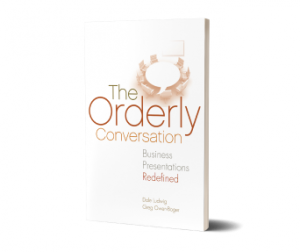
- Dale Ludwig Meetings, Presentations, The Orderly Conversation
We shot a few videos recently focusing on some of the fundamental aspects of our work. Here are two that define meetings and presentations as Orderly Conversations. Understanding the consequences of that definition helps facilitators plan and run more effective meetings.
Meetings and Presentations are Not Speeches
Transcript:
“When it comes to improving face-to-face communication, the most common hurdle people face is the misconception that presentations that take place during business meetings are formal speeches.
You only need to do a quick search to see that many trainers and consultants lump presentations and speeches together.
If you take a look at the images they use on their websites, you’ll see what I mean. They may be talking about presentations, but the images they use are of podiums, microphones, huge audiences with stages and giant screens. Those images do not represent the environments business presenters work in.
You deserve something better, which is why at Turpin Communication, we refer to meetings and presentations as Orderly Conversations.
Orderly because they are well-prepared and have a clear structure. Conversations because they require back-and-forth dialog to succeed, to get business done.
This fundamental shift in thinking informs how you should prepare for and facilitate meetings and presentations.
The rest of the videos in the playlist provide guidance for managing your Orderly Conversations.”
Business Communicators Succeed on Two Levels
Transcript:
“We can judge the success of meetings and presentations by how efficient they are and whether or not they moved business forward.
Too often, meetings are not successful. They might stall, go off the rails, become emotional, and end up wasting time. Often the next step coming out of one meeting is to hold another meeting.
To make sure that doesn’t happen to you when you’re leading meetings, it’s important to understand that Business Communicators succeed on two levels.
The first level is easy to understand. It’s about achieving your goal. For example, you might want people to buy, agree, align, or learn something.
The second level is about the process, how well you manage the conversation as it unfolds. In other words, you succeed by creating the conditions for a fruitful discussion.
When you do that, you earn trust and goodwill, make it easy for people to participate, and effectively manage the interaction. Over time, this leads to nurturing relationships, which makes the process even easier.
Often, people aren’t as successful as they could be on the first level because of failure on the second level. So, the next time you lead a meeting, focus on managing the process in a way that makes participating easy and productive. When you do this, you’re more likely to get the business of the meeting done.”


